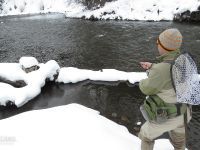From: 01/07/2015
To: 01/21/2015
Type of Water: Freshwater
Species: Rainbow trout, Brown trout, Whitefish
BIG WOOD RIVER
In the winter, midges make up a majority of a trout's diet. One positive outcome of the recent influx of silt from the fires in 2013 is that it has provided excellent habitat for midge larva along the deposition zones of the river. Already we are seeing decent numbers of adult midge clustering on the surface and fish feeding with abandon on certain sections of the river. This is a phenomenon typically only seen in late February and March. This bodes well for what is to come. In the meanwhile, be sure to take plenty of midge dries in addition to the usual subsurface midge patterns for winter angling. For dries, have a selection of trailing shuck midge, Griffiths Gnats, and high vis parachute midge patterns in size 18- 24. Also be prepared to fish dry dropper or Euro style. F View more...BIG WOOD RIVER
In the winter, midges make up a majority of a trout's diet. One positive outcome of the recent influx of silt from the fires in 2013 is that it has provided excellent habitat for midge larva along the deposition zones of the river. Already we are seeing decent numbers of adult midge clustering on the surface and fish feeding with abandon on certain sections of the river. This is a phenomenon typically only seen in late February and March. This bodes well for what is to come. In the meanwhile, be sure to take plenty of midge dries in addition to the usual subsurface midge patterns for winter angling. For dries, have a selection of trailing shuck midge, Griffiths Gnats, and high vis parachute midge patterns in size 18- 24. Also be prepared to fish dry dropper or Euro style. For nymphs, try Rubber Leg Stones, King Prince Nymphs, Zebra Midge, Bishop's Dynamite, Egan's Frenchy, the Red Dart, or the Iron Lotus. When selecting an access, note that much of the river is infiltrated with ice. However, the stretch below Warm Springs down to Rainbow Bend is mostly open and fishable. As the days warm up a bit, more water will be open and become ice free. With the ice build up along the river, be sure to wade with caution. I recommend you only use rubber soled wading boots with studs and a wading staff. And always fish with a partner. Having a change of clothes in the car is advisable.
THE BIG LOST BELOW MACKAY
The midge activity has also been good on the Lost and this is a good destination if you want to take a full day angling adventure. From Ketchum, it takes a little over two hours to drive to Arco and up to Mackay. For flies, bring a good assortment of Zebra Midge, Brassies, and other attractor nymphs like Rainbow Warriors or Bishop's Dynamite in size 16 to 22. For the best results, fish with stealth and fine tippet either dry dropper or Euro style.
THE SOUTH FORK OF THE BOISE
This really is a winter gem of a tailwater and worth the hour and a half drive from Ketchum. Of course, a well equipped winter vehicle is required on the ice roads; be sure to have studded snow tires, 4X4, and chains. A patient dry fly angler will find fish on the surface even on the coldest days. Small Baetis and midge patterns fished over rising trout or along the likely seams will produce. For nymph fishermen, try dry dropper or Euro Style rigs in the seams and tailouts. For flies, try small Baetis nymph patterns (18-20), Zebra Midge (18-22), Caddis Larva (12-14), Stone Fly patterns (10-12), or San Juan Worms.
SILVER CREEK
At the moment there is not much open water in the BLM stretch due to the ice build up on the banks. It has begun to warm a bit and we should see the ice recede. In the meanwhile, I would stick to the Wood, the Lost, or the South Fork. When the ice does break, fish deep and slow with buggers and nymphs. Remember, The Nature Conservancy portion of Silver Creek to the Highway 20 bridge is closed until the last weekend in May.






